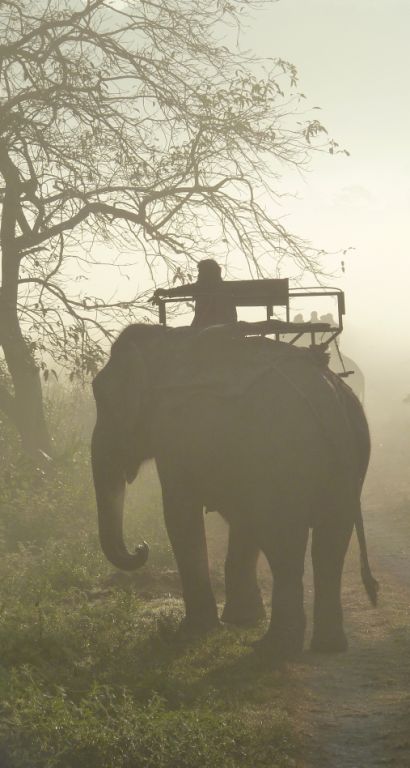
|
|
|||||||||
 |
| See all photos(13) |
| Other countries sue_and_nathan visited in New_life_in_Bombay |
| India (9) |
| ||||||||||||
| Cherrapunjee left us with great memories, aching legs and a bit of a dilemma about how to get to our next destination, Kaziranga. There seemed to be absolutely no easy public transport options and so we ended up hiring a taxi which after an eight hour journey, dropped us off at the Bon Habi Resort in Kaziranga. We weren’t expecting much from the hotel as previous experience has taught us that hotels in National Parks in India are either really grim or incredibly expensive. Happy to say that Bon Habi was neither! On our first morning we ventured out into the Park on elephant back, striding through long grass, hoping to catch sight of, what we thought, was the elusive indian rhino. It actually turned out that the indian one-horned rhino in Kaziranga is as plentiful as the stray dog in Mumbai and so within minutes, out of the early morning mist, we had spotted the first of these great beasts, mere feet away. The mahout made sure to give Mr Rhino plenty of space, just in case he didn’t fancy meeting us today, but luckily this fellow didn’t seem at all concerned about tourists on elephant back and continued to munch away at the long grass until he'd had enough and slowly wandered off. During our stay at Kaziranga we saw at least thirty rhinos and including a one-month old who looked rather like a large piglet with armour plating! There were also plenty of wild elephants, buffalo, hog deer and truly amazing scenery to keep us occupied. From Kaziranga it was onto Majuli, the second largest inhabited riverine island in the world, slap bang in the middle of the mighty Brahmaputra River. The Brahmaputra however has not been kind to Majuli and following an earthquake in the 50s which changed its course, has wiped away over half of the island. It is now just under 500 square miles and estimates suggest that by 2050, if Majuli continues to be eroded at current levels, it will no longer exist. The only way to Majuli is by ferry – a very overcrowded ferry – which carries everything from cars and goats to baskets of betel nut and elephants. Sadly there were no elephants on our particular ferry, although the fare list which clearly stated ‘Elephant with mahout – Rs800’ seemed to indicate that elephants and mahouts were probably pretty regular passengers. It’s difficult to describe Majuli, an island that is supposed to be the most organic spot in India because of the rich deposits that the Brahmaputra off-loads into the soil every monsoon mean that fertilisers are simply not needed. It feels like a hidden treasure, a place few people have discovered. The island is mainly made up of farms and small tribal villages where the Mishing tribe (of Tibetan origin many centuries ago) make up the majority. Majuli is the epitome of ‘unspoilt’, as are its inhabitants. Our days on the island were spent on bicycles, cycling on pathways alongside paddy fields and through villages of bamboo huts raised on stilts, stopping at the occasional ‘satra’ to learn more about the Vaishnavite culture. Sometime back in the 15th Century a philosopher called Sarkardeva came to Majuli with, it seems, the aim of making Hinduism more accessible to ‘the masses’. He translated some of the religious texts from Sanskrit into Assamese and developed dance-dramas to depict the life Krishna, the one-god whom he encouraged devotion of. He also established a number of ‘satras’ which were in essence schools to his teaching. Nowadays there are somewhere in the region of 25 satras on Majuli. We were welcomed into Uttara Kamallabari Satra by Gobind, a monk who has lived there for most of his life, along with around 99 other monks of all ages. That day we were particularly lucky to catch a performance which involved 8 young monks, accompanied by Gobind on the tabla, contorting their toned bodies into incredible but also beautiful dance positions. After tea and biscuits in Gobind’s quarters which he shares with one younger monk and one older retiree, we headed back through the villages to our very own bamboo hut on stilts, wondering how it is possible that so little is being done to preserve this gem of an island from the yearly onslaught of the Brahmaputra. | ||||||||||||
| Previous Entry: | Next Entry: | |||||||||||
| 3 Dec 2011 : Meghalaya - India | ||||||||||||
| Cherrapunjee - the rainiest place on earth! | ||||||||||||